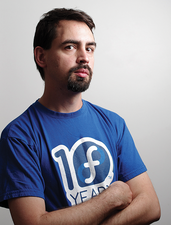The old hat that's still new
Distro Walk – Fedora

Matthew Miller, Fedora Project Leader, discusses Fedora's relationship with Red Hat and its role in the Linux community.
The Fedora Project [1] was started in 2003 as the community face of the newly established Red Hat Enterprise Linux (RHEL). Although sometimes dismissed as no more than a beta release for RHEL, Fedora quickly became a popular community choice as well, with numerous spins and builds. Twenty years later, it is also one of the main sources for numerous major commercial distributions, including RHEL, CentOS Stream, Rocky Linux, and AlmaLinux, as well as a dozen derivatives in its own right.
Matthew Miller has been Fedora Project Leader since 2014. As he prepared for Flock, the Fedora Project's annual conference, in Cork, Ireland, in August 2023, Miller kindly agreed to talk about the current state of Fedora.
Linux Magazine (LM): Tell us about your involvement in free software.
[...]
Buy this article as PDF
(incl. VAT)
Buy Linux Magazine
Subscribe to our Linux Newsletters
Find Linux and Open Source Jobs
Subscribe to our ADMIN Newsletters
Support Our Work
Linux Magazine content is made possible with support from readers like you. Please consider contributing when you’ve found an article to be beneficial.

News
-
Say Goodbye to Middle-Mouse Paste
Both Gnome and Firefox have proposed getting rid of a long-time favorite Linux feature.
-
Manjaro 26.0 Primary Desktop Environments Default to Wayland
If you want to stick with X.Org, you'll be limited to the desktop environments you can choose.
-
Mozilla Plans to AI-ify Firefox
With a new CEO in control, Mozilla is doubling down on a strategy of trust, all the while leaning into AI.
-
Gnome Says No to AI-Generated Extensions
If you're a developer wanting to create a new Gnome extension, you'd best set aside that AI code generator, because the extension team will have none of that.
-
Parrot OS Switches to KDE Plasma Desktop
Yet another distro is making the move to the KDE Plasma desktop.
-
TUXEDO Announces Gemini 17
TUXEDO Computers has released the fourth generation of its Gemini laptop with plenty of updates.
-
Two New Distros Adopt Enlightenment
MX Moksha and AV Linux 25 join ranks with Bodhi Linux and embrace the Enlightenment desktop.
-
Solus Linux 4.8 Removes Python 2
Solus Linux 4.8 has been released with the latest Linux kernel, updated desktops, and a key removal.
-
Zorin OS 18 Hits over a Million Downloads
If you doubt Linux isn't gaining popularity, you only have to look at Zorin OS's download numbers.
-
TUXEDO Computers Scraps Snapdragon X1E-Based Laptop
Due to issues with a Snapdragon CPU, TUXEDO Computers has cancelled its plans to release a laptop based on this elite hardware.

